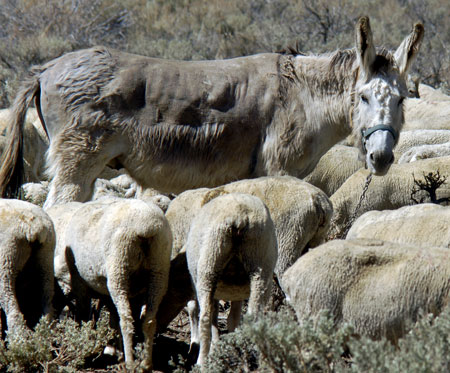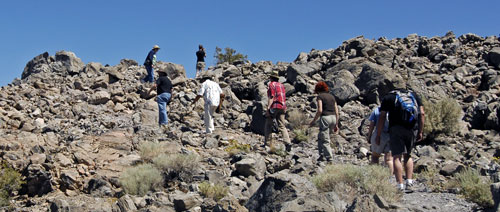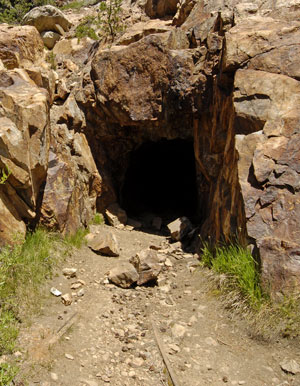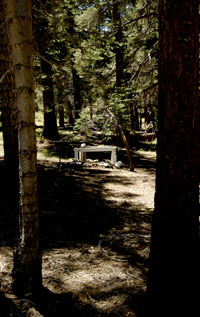“We tend not to choose the
unknown, which might be a shock or a disappointment or simply a
little unknown with all its disappointments and surprises that
is the most enriching.“ -- Anne Lindberg
Cornelia Gordon was
visiting friends in Los Angeles when word came that her husband,
Louis, had obtained the lease on an old worked out silver-lead mine
in Inyo County, known as Cerro Gordo.
 The
trek from Los Angeles to Keeler at the base of the mountain would be
an arduous one, but paled in comparison to the 23 per cent winding
incline up the Yellow Grade Road, where no automobiles had ever
gone. The
trek from Los Angeles to Keeler at the base of the mountain would be
an arduous one, but paled in comparison to the 23 per cent winding
incline up the Yellow Grade Road, where no automobiles had ever
gone.
Cornelia’s friends told her she was foolish to follow her husband
with their nine month old baby, up to the remnants of the old silver
boomtown. The nearest real town with a doctor was Lone Pine, nearly
20 miles away, and the only means of transportation back and forth
would be horse and buckboard or carriage. Cornelia had known from
the early days of their marriage that she and Louis would call the
God forsaken mining camps their home. The primitive tent camp of
Gold Circle in Midas, Nevada, had well rehearsed the Gordon’s for
what lay ahead of them in the California Inyo Mountains, as had time
spent in mining areas of Nevada, Utah, and Mexico, where Louis also
had interests.
The
little Gordon family was packed and ready to head across the vast
Mojave Desert from Los Angeles when Louis learned he would be
detained by business. Cornelia had already prepared the baby’s
formula for 24 hours, and couldn’t wait, so she boarded the
narrow-gauge train, just she and her infant son. Between the
thriving Los Angeles metropolis and the mines, there was one
overnight stop. The only accommodations available were a boxcar.
Cornelia settled in for the night, until her son’s hungry cries woke
her at five o-clock in the morning. As she fed him, she gazed out
the little window of the boxcar to the unforgettable beauty of the
sun rising over the desert.
Before
ascending into the mountains where the Cerro Gordo mines were
located, Cornelia arrived in Keeler at the shore of Owens Lake. With
her nine month old baby in her arms, she boarded some sort of wagon
which would take her up the infamous Yellow Grade Road. In the seat
behind her, another person sat, holding an umbrella for shade.
Somewhere along the precipitous eight mile journey, they would stop
to make a fire to warm the baby’s bottle for feeding time.
Nearly at
the top of the mountain peak, Cornelia and party arrived at the
Cerro Gordo mines. As they stepped out of the wagon, they turned to
the view of Keeler down below. Cornelia described the view of the
“dry soda lake turned the most heavenly blue...blue as sapphire”
with Mount Whitney towering in the distance.
A sad
looking cabin was provided for the Gordons to live in until a more
comfortable house could be built. The little place was so dirty
Cornelia had to get miners to scrub the walls and take up horrible
matting on the floor. Old green carpeting, brought in from Los
Angeles, was put down on the floor, and a nice table was provided to
sit and have meals, soon making the place quite homey indeed. Behind
the cabin there was a bathroom, with a galvanized zinc tub. Water
was heated and brought in from elsewhere, since there were no pipes.
When Louis finally arrived on the mountain, he was quite surprised
to see his wife, son, and the accompanying nursemaid quite content
in their humble quarters.
|
 |
|
A white
tent (upper right) sits near the future site of the
Gordon's home in Cerro Gordo.
(Photo
from L.D. Gordon Collection, courtesy Doug Gordon) |
Not long
after settling in, Cornelia learned that there was no milk to be had
in Cerro Gordo. She took a piece of paper and wrote out her grocery
list, including the much needed baby’s milk, and placed it in the
bucket full of ore that would travel down to Keeler via tramway.
Unfortunately, when the bucket came back up with supplies, the milk
was sour. This prompted Cornelia to visit Mrs. Bo, the only other
woman on the hill. Mrs. Bo informed her that she fed her baby
malted milk, but the little Gordon baby didn’t take well to the
malted milk. While thumbing through a magazine, however, Cornelia
soon found an ad for Imperial Granham, a powdered formula that
 just
required the addition of water to be complete. A note was placed
once again on an ore bucket which eventually came back up with the
Imperial Granham resolving the dilemma once and for all. just
required the addition of water to be complete. A note was placed
once again on an ore bucket which eventually came back up with the
Imperial Granham resolving the dilemma once and for all.
Cornelia
often found herself starved for adult companionship. “L” as she
called her husband, would be gone all day, then take off again after
a 5 p.m. dinner and go back down in the mines for the evenings. She
longed for good conversations or book reading together, but there
was never time for it. With no house keeping facilities in her
little cabin, she did manage to cook for the baby, get breakfast and
a light lunch, then a fine dinner would often be had at the house of
one of the wives of the other miners, relieving her loneliness.
Wind was
ongoing, and often very blustery. When a stockholder came to visit
the Gordons one day, Cornelia watched as he got to the little porch
in front of the house, and hurried to greet him. Just as she swung
open the door, a blast of wind blew the man’s beautiful white hair
off of his head, revealing his bald head. The incident must not have
bothered him much, as soon afterwards he sent Cornelia a horse, and
her life changed.
Astride
Prince, perhaps with her young son in tow, and a friend from Lone
Pine with her, Cornelia could enjoy the beauty of the old mining
town. The trails were scary at first, narrow, off camber, and rocky,
with drop offs looking down as much as 5,000 feet below in places.
The reward of wildflowers and pine scents as one descended into the
mountain trails away from the barren terrain of the mine itself, was
well worth the effort, however, and soon Cornelia conquered her fear
of horse and height.
Once
Cornelia’s son was old enough to walk. She was delighted to take him
on walks along the surrounding trails, instead of riding. At one
point they were greeted with a beautiful sight - a curly horned
mountain sheep. Along the way, they enjoyed more wildflowers, and
snacked on pine nuts. Douglas Gordon would be too young to remember
these nature walks, but his mother would treasure them forever.
 |
|
Cornelia
holds her son's hand (center) as they walk among workers
at Cerro Gordo.
(Photo
from L.D. Gordon Collection, courtesy Doug Gordon) |
Cornelia
spent time off and on at Cerro Gordo over the years her husband was
in charge of things. For the most part, she probably spent the
milder summer months on the mountain. However, there was one
Christmas when the Gordons couldn’t get away. The weather was cold
and snowy, yet sunny, with crisp and clear blue skies. The only
thing that was missing was the tree. The miners went out and cut a
little pine tree so the Gordons could have a Christmas tree.
Cornelia decorated it with decorations both homemade and bought, and
the holiday was complete.
 |
|
A
snow-covered Cerro Gordo in the days before the Gordon
house was built.
(Photo
from L.D. Gordon Collection, courtesy Doug Gordon) |
Decades after
the Gordon family left the Cerro Gordo mines, Cornelia recorded
these experiences and many others on a new fandangled tape recorder
given to her by a granddaughter. Somehow she managed to “tame” the
thing, with the help of a nurse at the retirement home where she was
living.
Future
generations of Gordons and ghost town explorers can now enjoy the
memories of a nearly forgotten time. Although, she never mentioned
it, the little cabin was not the only home Cornelia and her family
lived in. Eventually, a large two story wooden shingle house with
all the comforts of the day, was built, and remains standing as the
most prominent building, other than the American Hotel. at Cerro
Gordo today. The Louis D. Gordon House, circa 1916, is currently
the home of town owner Mike Patterson.
 |
|
A
workman poses by the nearly completed Gordon house at
Cerro Gordo.
(Photo
from L.D. Gordon Collection, courtesy Doug Gordon) |
|



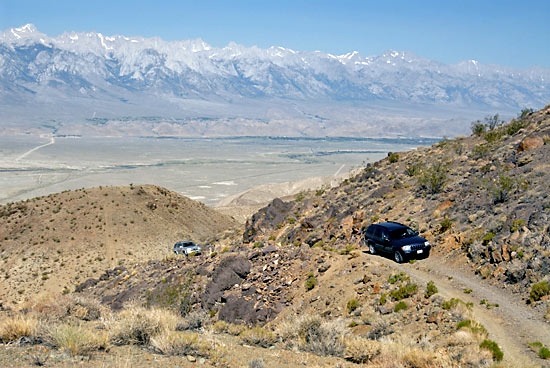






 The
trek from Los Angeles to Keeler at the base of the mountain would be
an arduous one, but paled in comparison to the 23 per cent winding
incline up the Yellow Grade Road, where no automobiles had ever
gone.
The
trek from Los Angeles to Keeler at the base of the mountain would be
an arduous one, but paled in comparison to the 23 per cent winding
incline up the Yellow Grade Road, where no automobiles had ever
gone. 
 just
required the addition of water to be complete. A note was placed
once again on an ore bucket which eventually came back up with the
Imperial Granham resolving the dilemma once and for all.
just
required the addition of water to be complete. A note was placed
once again on an ore bucket which eventually came back up with the
Imperial Granham resolving the dilemma once and for all.





